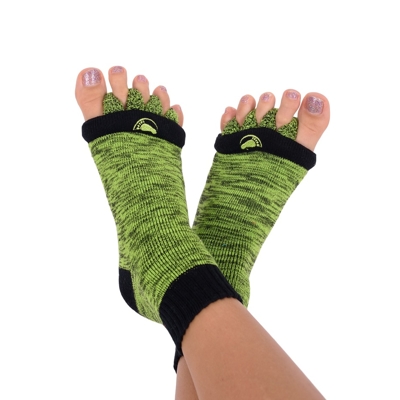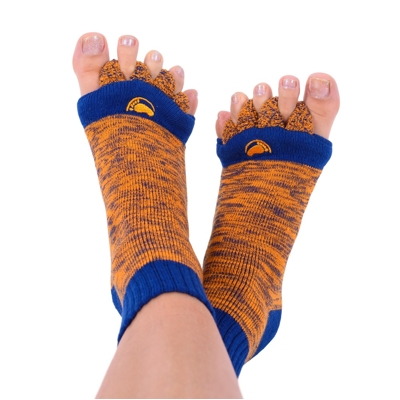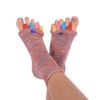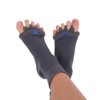How to straighten a hallux valgus without surgery
 Hallux valgus is something that many women and men suffer from. At first glance, a much greater problem lies behind this unsightly deformity than just its unnatural appearance. And what’s more, if it is not treated, it can eventually require surgery. However, if the underlying causes are not dealt with, the disorder can reappear. What should one do to straighten a hallux valgus without the need for an operation? Take a look at our tips.
Hallux valgus is something that many women and men suffer from. At first glance, a much greater problem lies behind this unsightly deformity than just its unnatural appearance. And what’s more, if it is not treated, it can eventually require surgery. However, if the underlying causes are not dealt with, the disorder can reappear. What should one do to straighten a hallux valgus without the need for an operation? Take a look at our tips.
What hallux valgus is and how it is manifested
Hallux valgus is immediately recognisable. Your big toe starts to bend towards the other toes and as it rotates in the metatarsophalangeal joint, the joint starts to push outwards. Poorly fitting shoes can cause a painful swelling or growths to form at the metatarsophalangeal joint, which you might be familiar with in connection with heel spurs. By then you might experience pain when walking or when under other strain and its unnatural shape means that the foot is squeezed tightly in the shoe.
Hallux valgus is most commonly the result of a drop in the transverse arch of the foot. Contracted muscles of the sole are to blame, the most significant being a shortened abductor hallucis. The more the abductor hallucis is shortened, the more the big toe is pulled towards the other toes. Hallux valgus can also considerably limit mobility due to the joint being blocked.

The causes of hallux valgus include unsuitable footwear, excessive strain on the foot, long periods of static load or a poor gait stereotype. Unfortunately, one can also be congenitally prone to hallux valgus. It depends on the length of the first metatarsal bone or factors such as the strength of the ligaments in the foot and thus joint hypermobility.
The best time to start dealing with hallux valgus is as soon as you notice the first symptoms. How? We present several tips below.
Have your hallux valgus taped
It is physiotherapists that most commonly specialise in kinesio taping. However, anyone can do a kinesio taping course. The physiotherapist will use special flexible adhesive tape to bind your hallux valgus to reduce the strain on the big toe when you walk or to relieve pain. Kinesio taping is generally used as a method of aiding prevention, alleviating pain and to speed up the treatment of injuries or health complications relating to the muscles, tendons or joints, for example.
Do special exercises
There are numerous exercises for hallux valgus. We’ve put together a special article entitled Exercises for hallux valgus that will help you, that describes them clearly, including video guides on YouTube. These include loosening up the big toe, relaxing the sole and toes, stretching the abductor hallucis, activating the transverse, and others. One great advantage is that you can do all these hallux valgus exercises yourself in the comfort of your home. This means you don’t have to go anywhere and don’t need anyone else to do them. Also, exercises to alleviate hallux valgus are not physically demanding or time-consuming. Just spend a few minutes doing them every day and you’ll soon see results.

Change your footwear
As we mentioned above, hallux valgus is often caused by unsuitable footwear. What does this mean, though? There is no one single type of footwear suitable for everything. First off, you should choose footwear to suit the purpose you plan to wear it for.
In general, however, unsuitable shoes are those that squeeze the foot (at the toes or along the whole of the foot), force them into an unnatural posture (excessively high heels, curled toes), do not breathe (non-breathable materials), as well as footwear that is too stiff. We’ve also devoted a separate article on suitable footwear and how to choose it - 5 tips on choosing the right footwear, so you know what to bear in mind.
It is definitely worth mentioning barefoot shoes, which have a number of benefits. However, even these are not universally suitable for everyone. You can read more about this in one of our articles.
Try orthopaedic insoles
Orthopaedic insoles are most commonly used to treat flat feet. Hallux valgus and flat feet are connected, as they are caused by similar factors. You certainly can’t go wrong if you decide to treat your hallux valgus with orthopaedic insoles. Orthopaedic insoles help to evenly distribute the load on your foot, which can also relieve your hallux valgus. We recommend discussing the choice of suitable orthopaedic insoles beforehand with a specialist.
Wear The Original Foot Alignment Socks
Foot Alignment Socks help you to stretch the muscles of your foot, including the critical abductor hallucis. The toe spacers correct the position of the big toe by slightly bending it away from the other toes. After wearing Foot Alignment Socks, you will feel an overall sense of relief, and less pain. Start by wearing them for just a few minutes a day, until you get used to wearing them for longer.

Foot Alignment Socks themselves will not cure your hallux valgus problem, however. It is best to choose a combination of the above tips to achieve the most noticeable effect. However, if you are not sure of the severity of your problem, we strongly advise you to consult a doctor or a physiotherapist, who will recommend suitable steps to improve your condition.
The key points of this article
- hallux valgus is a deformity that you can recognise simply by its appearance
- hallux valgus is associated with a shortening of the foot muscles, particularly the abductor hallucis
- hallux valgus is also often accompanied by flat feet
- surgery may be required if the deformity is not dealt with
- it is also important to focus on eliminating the causes of the problem
- the following can help to treat hallux valgus:
- kinesio taping
- special exercises
- wearing suitable footwear
- orthopaedic insoles
- Foot Alignment Socks









